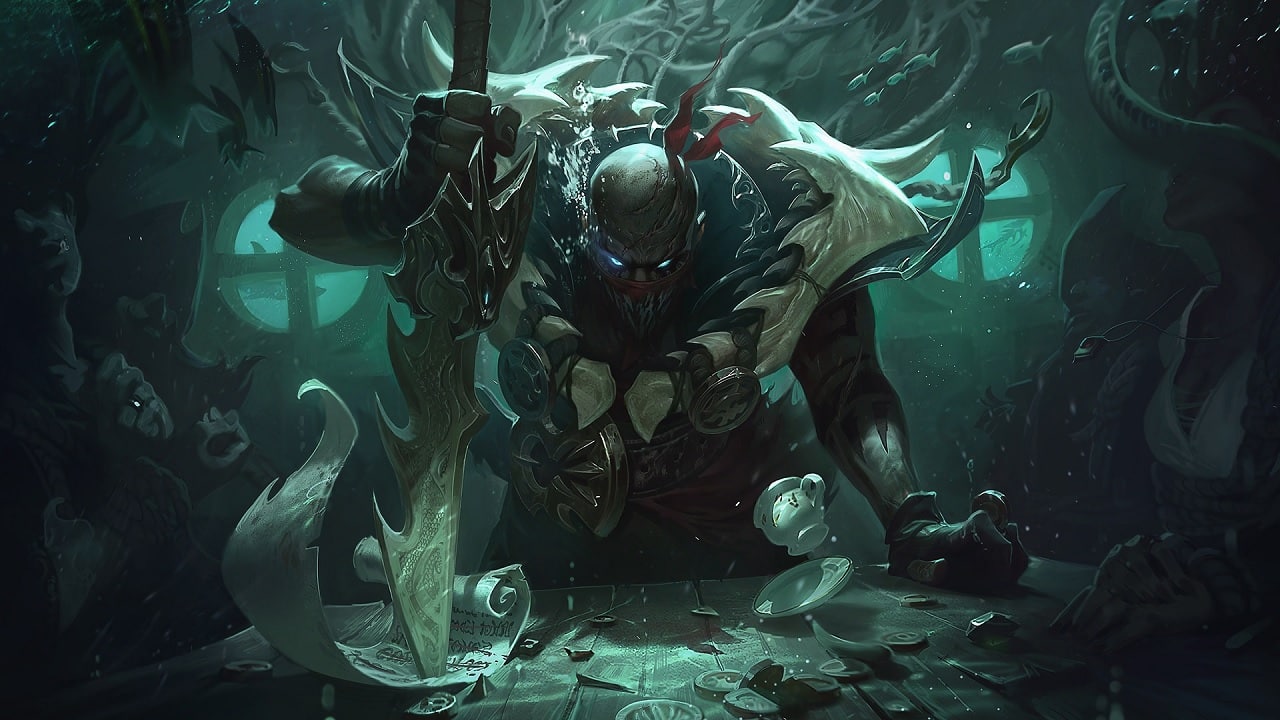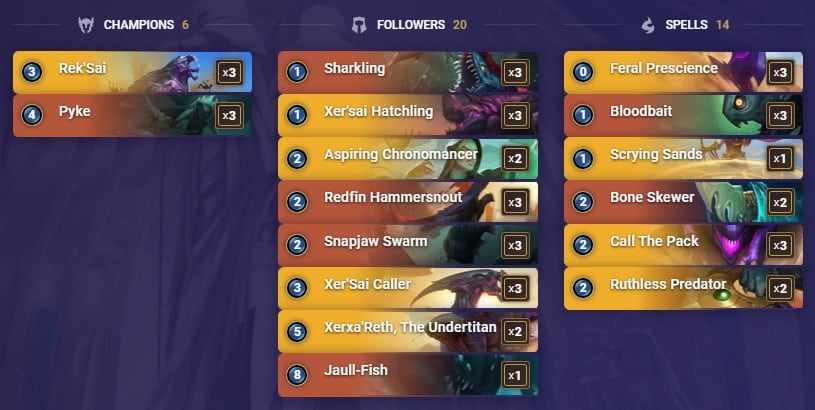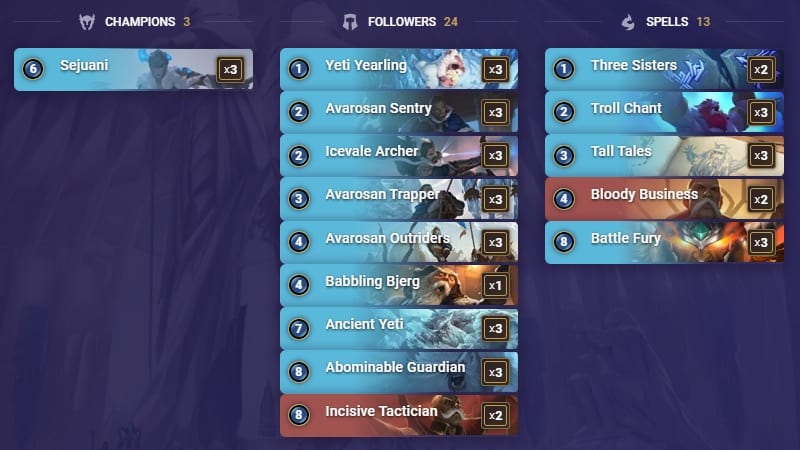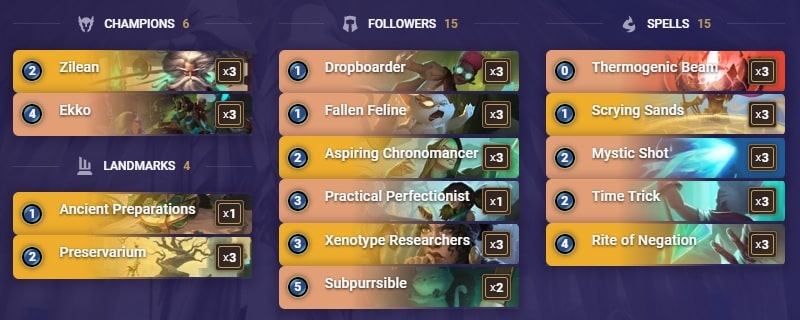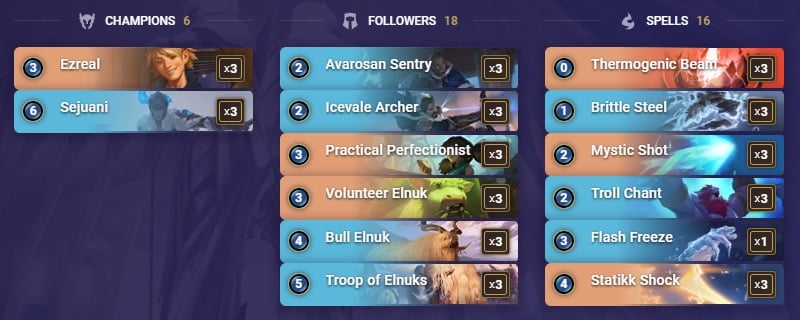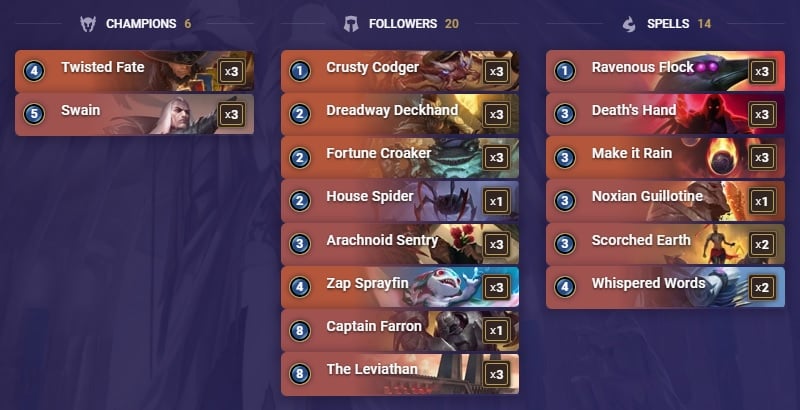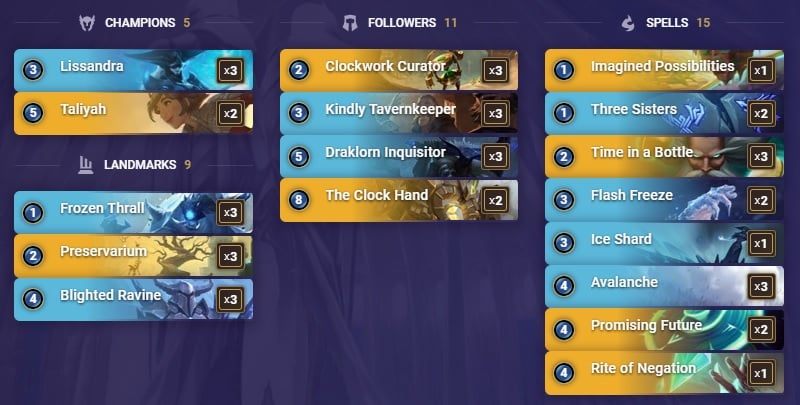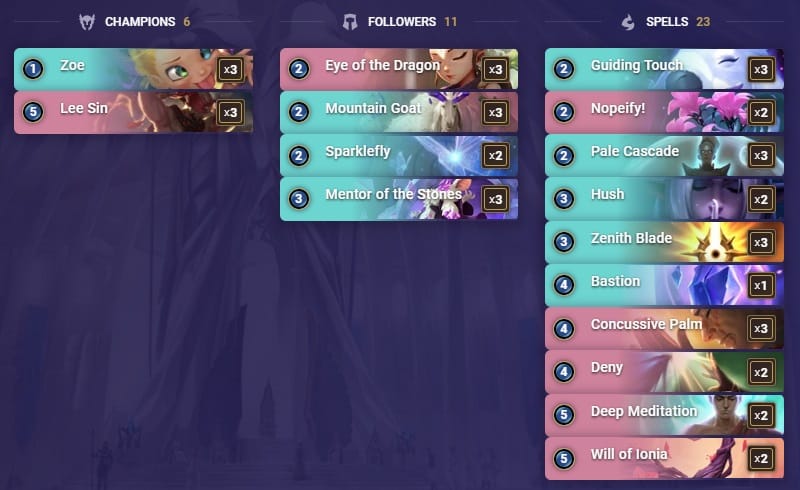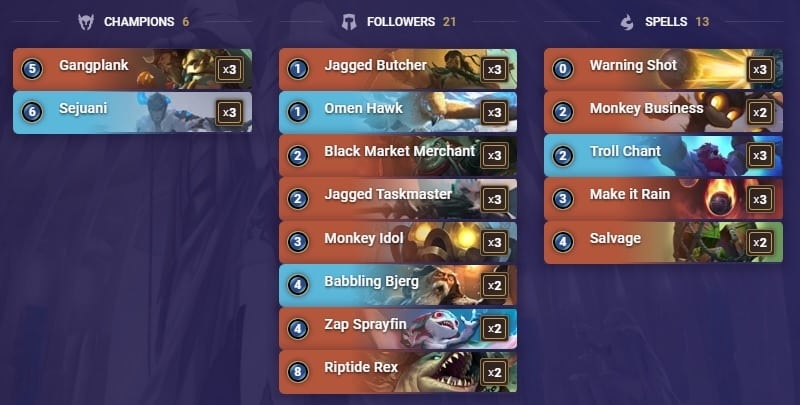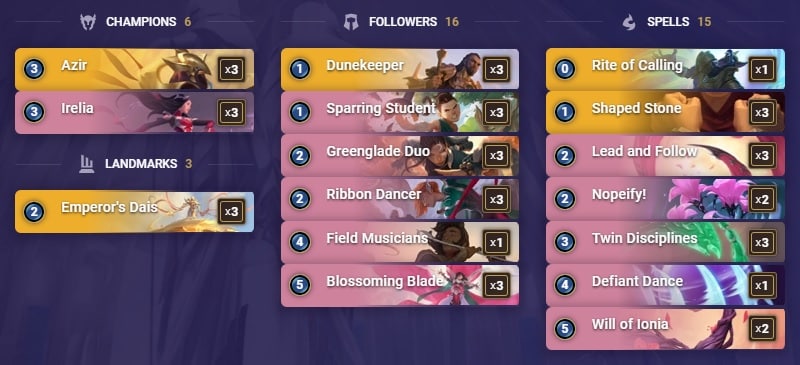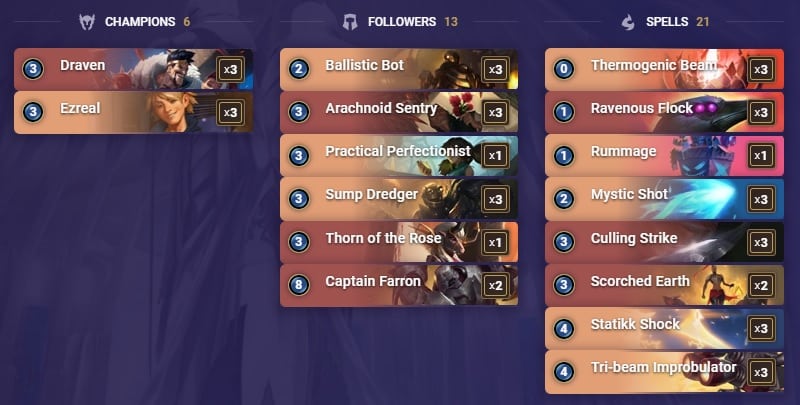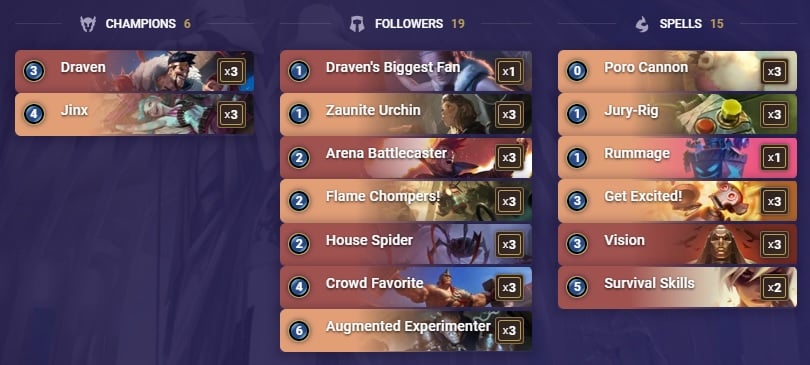Welcome to TLG’s latest article for Legends of Runeterra. Today, we’re bringing you our usual deck report, as the Rise of the Underworlds expansion was released last week. The new cards (and a gigantic balance patch) have injected some much-needed juice into the game, so we’re excited to give you some of the most compelling deck ideas.
Given the early state of affairs, don’t expect much in the way of refinement. Enjoy the expansion and dive into one of the new, returning or updated archetypes.
If you have any questions, feel free to drop by our Discord. Best of luck on your climb!
Graphics: WellMax81
Editing: Wusubi, Sebodunum
Writers: Den, Ultraman, Othal

CMBAKBAGAEBQIBIPAUCAOE2EJJIFGAQBAQDAEAYEA4AUCRICAECAMBYBAQDU6
Difficulty: Moderate
It’s summertime. Beaches are full, comprising a vast amount of sand and saltwater, where the common people might come to forget the vicissitudes of life, if only for a while. They play around, they laugh, they rest. But not you. You wait, you plan... you lurk.
Pyke and Rek’Sai are here with you, hand in hand, waiting. You know the right moment is coming. You predicted it, listening to your Feral Prescience. You play them, a constant threat. But just one strike with the Bone Skewer and they’re back at the top of the deck, patiently lurking again.
You cover Rek’Sai in Bloodbait, making sure to attack relentlessly, boosting her packmates even during your opponent’s turn. The ground shakes. She’s here, ready to feed on the weak. You attack, and her cry bolsters your lines.
What can puny mortals hope to do against your array of 10/1 Fearsome 1-cost Xer’sai Hatchlings? Your opponent can fight, they can struggle, but what can they do to stop Pyke and Death From Below?
And when they watch, bloody and battered but still breathing, proud to have dealt with your first wave of creatures, it will come, drawn by blood in the water. The Snapjaw Swarm, and its relentless pressure. During your turn, during the opponent’s, always here to catch your prey off-guard. (Write-up by Othal)
CECACAYBAIAQEAICAECACEQIAEAQGBILBYPSKMBTAIAQIAIKAICAGCAPAEAQCAIH
Difficulty: Easy
This expansion has offered a lot of flavor when it comes to tribes, and it’s possible that the Yetis are the ones who got the most out of it. First seen as a gimmick deck, the attention towards the archetype has changed now that someone used the deck to race to Masters in just two days.
While it was paired with PnZ at the time, using the Iterative Improvement to get even more Yetis onto the board, I decided to work on a more pressure-oriented deck, utilizing the almighty Noxus as the support region.
Several cards could’ve made the cut, and Reckoning is one that I think could find its way into the deck. But the star of Noxus when it comes to helping our big furry friends is Incisive Tactician, as once the Yetis are dominating the board, the only thing you want is to finish the game before your opponent can recover from it.
As such, a touch of the Reputation package comes in to help with a Rally and a removal spell in the form of Bloody Business. Almost exclusively built to pressure the opponent, this deck isn’t so bad at defending, because 5/5 bodies are just solid.
The Yeti archetype can be considered one of the best pure board decks out there and combined with the support tools in the Freljord region, can sometimes have the same vibe as the Overwhelm deck of the previous meta. And just like that deck, Yetis aim at being the ones who pressure and force the opponent to take action so as to desperately fight back against the pressure.
For most decks, I would advise you to have a plan, carefully assess the situation and take calculated risks. When playing Yetis, don’t bother with any of that! You have big, resilient units and most decks can’t keep up when you start the snowball. If you notice a small chink in your opponent’s armor, smack loads of Yetis at it until it breaks.
In addition to these chunky units, the deck has enough freeze and support spells to make it awkward for any opponent that would have to take a risk to come back into the game. (Write-up by den)
CMBQEAIEDM2AIBAEAEBAIBYGAQDQCCYNE45U6AIBAICACAQBAQCAYAIEA4OA
Difficulty: Hard
After a difficult start to the expansion, with the deck being touted as too fragile to stay relevant in the highly aggressive early days of the meta, it looks like this PnZ and Shurima pairing has found its stride.
Mostly a tempo destroyer against board-centric strategies like Lurk, the deck has evolved and it now looks like it’s capable of defending against early aggression while also being good enough to sustain a late game battle thanks to Ekko, Preservarium and Subpurrsible.
Held back by the lack of healing, the deck needs a good start right off the gate to create tempo and protect its Nexus, but once that part is covered, we have a real contender on our hands. What’s more, the Predict mechanic might finally feel like it isn’t too slow to work in a tempo-oriented deck, as Dropboarder and Fallen Feline are helpful with generating tempo.
The main thing to consider when picking the deck is the fact that it’s difficult to pilot, as each turn is filled with potential pitfalls. Errors can cost a lot of health, which is impossible to recover later on in the game. It’s therefore very difficult to recommend the deck as a “pick it and have fun with” kind of a list, and trial and error definitely is part of the experience.
Depending on the direction the meta takes from now on, the deck could either rise or fall, as it would be hard for the deck to adapt to a return of the heavy damage dealers such as Thresh-Nasus and Azir-Irelia. But for now, if ladder stays focused around Lurkers, Pirates and other board-centric decks, Zilean-Ekko could be a decent option to climb with, once you go through that dozen or so games it takes to get a feel of the deck. (Write-up by den)
CECQIAIEDMPSINAFAEAQGCYRDMPACAYBAIBAIBAMBUAQEAICAAAQCAIBAE
Difficulty: Moderate
A lot of people were expecting Elnuks to be a contender in the upcoming meta when Volunteer Elnuk was revealed. And to be honest, they had some time in the spotlight in the early days of the expansion. But as time passes and lists are getting refined, we can see that although the high-roll potential was there, the stability level was weak for something that wants to be a good climbing deck.
Elnuks are great at developing a wide board out of nowhere, but the problem is that the deck doesn’t do much outside of that. On paper, Frejlord and PnZ are both great to block the game and guarantee yourself sufficient time to set-up Troop of Elnuks, allowing you to summon 3-4 units at once.
In reality, the Elnuks are more of a distraction until Ezreal can come in and damage the opponent because by Turn 5 or 6, most decks have the capacity to have a good enough board to successfully take on the Troop of Elnuks. Outside of the slower decks, which would have a hard time dealing with the explosive development purely with spells, Troop of Elnuks feels like it has to be incredible in order to match our opponent’s pressure.
The deck is still a lot of fun, but it simply doesn’t look cut out for a high performance objective if you would be looking to climb the ladder up to the Masters ranks. Yet, a good Troop of Elnuks swinging the board against an Aggro deck is one of the better feelings you can experience in today’s meta, which might be more than enough for some to warrant playing this deck.
As such, Elnuks might end up being a package in some decks that would benefit from the board-swinging ability and use that mechanic as a support to do so. But with 2 regions being necessary to make the synergy work, it’s difficult to imagine Elnuks living up to the potential a lot of players were seeing in them when it was still the reveal season. (Write-up by den)

CICACAIDFYBAGBQIB4CAEBQEDITC2BACAMAQOCAJAIAQGAYNAECAGAQBAMAQGFRTG4
Difficulty: Easy
Bilgewater is back - all it took was to buff Make it Rain by making it 2 mana again. This should tell you enough about the card’s power level. That being said, the card is first and foremost an enabler for other spells like Ravenous Flock and Scorched Earth, as well as for Swain’s level-up. It greatly helps you deal with opposing aggression while retaining some flexibility.
Use Swain’s level-up to stun the opposition before getting rid of them thanks to a decent 3 damage AoE, while The Leviathan helps you set-up and finish off the opponent at the same time.
If for any reason your opponent tries dealing with every one of your cards as soon as you drop them on the board, you can rely on good ol’ Captain Farron. He gives you 8 extra reach, which usually allows you to end the game before you run out of steam! (Write-up by Ultraman)
CMBQEAIBCQZAGBAHBUWEEBAEAEAQKBQOAMAQCAIBAECACCQDAQDR6ISJAIAQIAIJAICAOO3Y
Difficulty: Moderate
Thralls benefit from the Freljord control package at the same time as having an actual low curve, getting 8/8 Overwhelm units on the board as soon as Turn 5. This forces the opponent to make a choice between giving you a strong AoE, or dealing enough damage to force you to play defensively.
The deck often asks you to take a lot of risks, such as tanking up damage in order to pop off a stronger combo. The way you do this is through Taliyah and Promising Future, potentially stealing the game due to an attack with quadruple 8/8 Overwhelms.
Watch out for Landmark removal and don’t overcommit on one of your Landmarks if you suspect your opponent plays them. Hold onto the multiple freezes to help keep your followers alive when defending and attacking in the name of the Ice Queen! (Write-up by Ultraman)
CIBAGAQCAMCQMBQDBEERWIZJGNOAIAICAIEQCAYCCQBACAQCGEBAGCJIKUAQCAYJCM
Difficulty: Very hard
The despicable monk, hated by many and loved by none, is back on the menu thanks to Will of Ionia being buffed to 4 mana. While Zoe’s spell got nerfed, many strong Ionian cards stayed in the deck.
Lee Sin is as hard to kill as always, thanks to the barrier he protects himself with each time 2 spells are played, while Sparklefly and Eye of the Dragon provide Lifesteal which helps you stay alive against aggression. This deck packs Concussive Palm and Will of Ionia as awesome control tools to gain tempo and survive longer, in addition to a ton of draw to help you find Lee Sin.
Zenith Blade is your final win condition, by either getting Lee Sin leveled-up with Overwhelm with the aim of OTK-ing your opponent in the blink of an eye, or just getting a follower so massive and protected that they’ll slowly but surely destroy the opposing Nexus. (Write-up by Ultraman)
CICACAIBCYAQEAICAEBQCAQHAIDBIIBBEIWTOOQDAEAQCBYBAMDA4AYCAYOB2JQA
Difficulty: Easy
A never-ending streak of Powder Monkeys and Plunder triggers that level your Gangplank and Sejuani sounds like an amazing plan on paper. Before Make it Rain got buffed, it wasn’t good enough in practice. But now, Make it Rain can make use of Kegs while enabling Plunder, on top of advancing GP and Sejuani’s level-up conditions.
Babbling Bjerg is a notable inclusion here, as he draws into your three biggest threats: Riptide Rex and both of your champions. Zap Sprayfin and Salvage help you avoid running out of steam too early for Rex to give them hell.
Your champions have Overwhelm, and, as such, benefit greatly from Gangplank’s AoE attack, which deals damage to both the enemy blockers and their Nexus. This allows you to deal more direct damage, until either Warning Shot or Rex finish the job.
The extra damage from the Powder Monkeys helps greatly with both of the crucial aims of this deck - to activate Plunder and level-up your champions. All in all, this deck forms a very synergistic approach to Bilgewater, and is perfect for those that enjoy the longstanding human pastime of making things go boom! (Write-up by Ultraman)

CMBQGAICAYGCUBAEAICAKCILAQCAOAY2GNOQEAIBAIBACAYCCQBACBAHPEBAIAQBBA
Difficulty: Moderate
The best deck from the previous meta got rather butchered in Patch 2.11.0, as both of its champions were nerfed, along with a couple of important non-champion cards, leading to most players considering the deck dead and buried.
However, Ionia also saw a lot of its cards buffed, like Twin Disciplines or Will of Ionia. Both of these have made their way into the new iteration of the deck, one that several Masters players have been experimenting with.
In the end, the deck looks like it isn’t so far from its old self, and there currently are several players in Top 20 Masters who had good results with the deck. For now, though, the early meta is (as always) aggressive. Playing Azir-Irelia might feel like a chore at times as the deck has lost a bit of its former early game craziness with your champions leveling-up a turn later on average.
Don’t fool yourself though, when given a bit of time, it remains one of the better decks out there and delivers board pressure like no other. It was the high-roll potential that got nerfed, not the deck’s stability. The deck still rocks a low curve, making it hard to have unplayable hands, and still packs cards that create impactful early game pressure.
The addition of Twin Disciplines makes it easier to protect your champions, giving you survivability against spell-oriented decks and leaving almost only pure Aggro as an option to keep the deck in check. Field Musicians are another interesting comeback, or Shadow Assassin for some players. Those cards are helping the deck with draw and longevity in general, corroborating the idea that the deck has become a bit slower.
Those inclusions might not feel entirely necessary for now, but the nerf of Dancing Droplet definitely left a mark, as it removed a low cost draw option for the deck. While it wasn’t used so much for its drawing ability, having that possibility was important, as its loss of Attune now means that we’re forced to incorporate a similar option in the deck through a much more costful card.
The current meta is essentially looking to destroy combo and control decks, which outside of Thralls are fairly quiet on ladder for now. Much like in the previous meta, then, Azir-Irelia should be a player in the coming months and could limit what players are allowed to play if its popularity were to rapidly rise again at some point. (Write-up by den)
CECACAQDBEBAGBAFCEBQCAYECQXAKAIEDMPSIJRUAIAQCAZTAEBQGDIDAEAQIAIBAQBQUAIEAQGA
Difficulty: Easy
Ezreal-Draven certainly lost a bit of tempo with the nerfs, but overall it’s been nothing too serious for the deck, as it can delay the use of those nerfed spells until it finds better timing for them. It will remain a powerful deck to face, with many removals and many ways to stop you from taking control of the board.
While ahead of you, the deck will use minimal mana to clear your board, helping it secure its pressure until it can deal damage to you and break your Nexus. As Ezreal-Draven, you rely mainly on getting the most out of your turns, aiming to set-up a good Tri-beam Improbulator and level-up your Ezreal.
With Captain Farron and a leveled-up Ezreal, you’ll end up forcing the opponent into removing your threats rather than healing themselves, putting them into an almost inescapable bind: they either have to finish you that turn, or they’ll slowly succumb to the myriad threats the deck has to offer. (Write-up by Ultraman)
CEBQCAYECICQCAYHBEKCONYGAECAYDI4E4UC2AIBAMBQ6AQBAEBSGAIBAQAQ
Difficulty: Hard
Discard Aggro isn’t the most popular aggressive deck out there; Pirates is an example of a deck you might see a lot more of while climbing the ladder. But if experience has taught us anything, it’s that Discard usually ends up as the best aggressive deck of the bunch, and for a simple reason: it’s very flexible.
While the deck has some new cards to consider, the rather harsh nerf of Rummage to 2 mana has made most of them difficult to play, so the deck stays in its classic form for now. It’s notable that this is the only clear nerf to an aggressive deck this patch.
Rummage appears to be a key part of Discard Aggro’s strategy and synergy in this regard, especially with the release of new cards such as Boom Baboon. Sadly, now that it’s at 2 mana, it’s inadvisable to run more than one copy of Rummage due to its newfound clunkiness, and any new cards are less likely to be included as a result… once.
Like any aggressive deck, Discard benefits from the absence of Shadow Isles and the nerfs to Targon’s healing tools. As such, Aggro decks are a decent choice for climbing, whether you like Pirates, Shurima Burn or Discard.
I would expect some counters to arise as time passes, and pressure strategies will certainly be forced to evolve into something more complex to counter these in turn. But for now, basic builds like this one, featuring Arena Battlecaster, a card that’s only useful when it doesn’t instantly die, look to do what’s expected of them: win some games. (Write-up by den)

Trundle-Lissandra Control (TLC) has been a staple of the meta since it was first released. The main reason it stopped being so prominent on ladder was the insanely high playrate of Azir-Irelia. As a deck with a clear-cut win condition, no interaction with the opponent (except when it came to obliterating their deck) and a lot of tools to get there easily, TLC had one of the highest power levels we have seen in Legends of Runeterra. So, what led to its downfall? (Write-up by Othal)
Everything changed when Patch 2.11.0 arrived. Watcher now needs 5 allies to be summoned and doesn’t give an instant-win, but leaves 3 cards in the enemy deck - closer to a Maokai level-up than the powerhouse it was before. While it may seem this change is simple, it has huge consequences for the TLC Matron combo.
Firstly, it has become harder to proc the full combo in one turn. It involved playing double Pillar and using Spectral Matron on the first Watcher to get the second one for free. You’ll now need a third Pillar, via Fading Memories or another Trundle, which requires more set-up and more board space. The latter can be hard to find, as Matron doesn’t allow you to replace a unit when summoning and Lissandra creates a Landmark.
Secondly, the fact that you don’t win in one go forces you to commit a real Watcher, otherwise you’re open to a counter-attack. The units summoned by Matron and Fading Memories are Ephemeral, which will most likely leave you with at best a 6/6 and a Vulnerable 0/6 when you’re done attacking without a true Watcher.
Last but not least, the removal of the instant deck obliteration leaves you without a win condition. Deep, for example, summons a lot of low-cost, high-stats creatures and uses them to win the game, or hold for a few turns if Maokai is leveled-up.
With TLC, you have no resources to help you get there, no secondary threat your opponent must deal with. Three cards in their deck might not seem a lot, but slow decks might have enough resources to close the game on Turn 9 or 10, while your win con has already been spent.
But as a wise man once said: that is not dead which can eternal lie, and Watcher is no exception. While TLC might not see play, Thralls are on the rise in this new meta and they solve the issues I just mentioned: Watcher isn’t the main win con, but can still be summoned and force your opponent on their toes while they have to deal with a board full of 8/8 Overwhelm Thralls.

